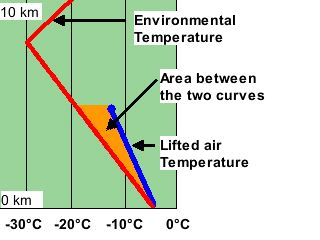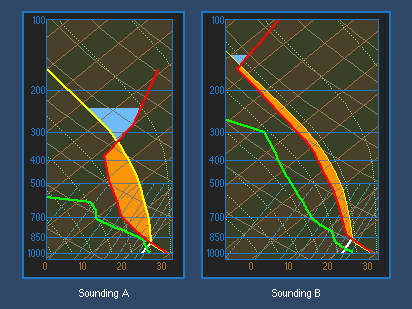|
CAPE
In an unstable environment,
the temperature of rising air can be traced and compared to
the vertical profile of the environmental temperature.
|
The area between these two lines is
representative of the available energy a storm could use to grow.
This energy is call CAPE (Convective Available Potential Energy)
and comes from the energy released when water
condenses.
|

|
Meteorologists use more sophisticated diagrams
(like the skew-T diagram below) to determine the
relationship between the temperatures of the environment
and the rising air. Here the red line still represents the
environmental temperature.
This movie shows surface air which is lifted into
unstable air.
The thin yellow line is tracing the rising air's temperature.
The orange area between these curves is related to the
amount of CAPE present.
[Embedded Object: CAPE Movie (182K)]
The original source of this image is the
Cooperative Program for Operational
Meteorology, Education and Training (COMET®) of the
University Corporation for Atmospheric Research.
Copyright © 1996 University Corporation for Atmospheric Research.
All Rights Reserved
There are two aspects of CAPE that meteorologists look at when
diagnosing severe storm potential --
the size and the distribution of the orange area.
The size (or magnitude) of CAPE is important as it describes the
potential strength (e.g. updraft speeds) within storms.
However the distribution of CAPE is just as important.
This is because the same CAPE (orange area)
could come from an environment with a large temperature
difference over a shallow level or from a smaller temperature
difference over a deeper level. The diagram below
shows this. The orange areas (and therefore CAPEs) are identical.

The original source of this image is the
Cooperative Program for Operational
Meteorology, Education and Training (COMET®) of the
University Corporation for Atmospheric Research.
Copyright © 1996 University Corporation for Atmospheric Research.
All Rights Reserved
Notice how in the sounding A, the difference in
temperature between the environment and the rising air is much
greater than in sounding B. This means that the rising air in
sounding A is more buoyant with respect to its environment than
that of the air rising in sounding B.
Stronger updrafts
and more severe storms
are likely in sounding A.

wind shear
|
|

NCSA Access Article
|
|



